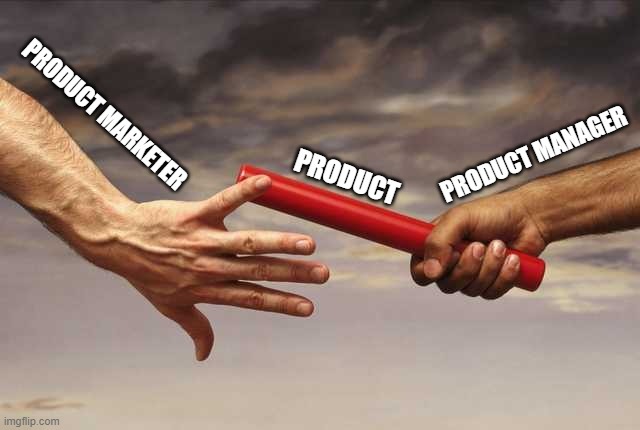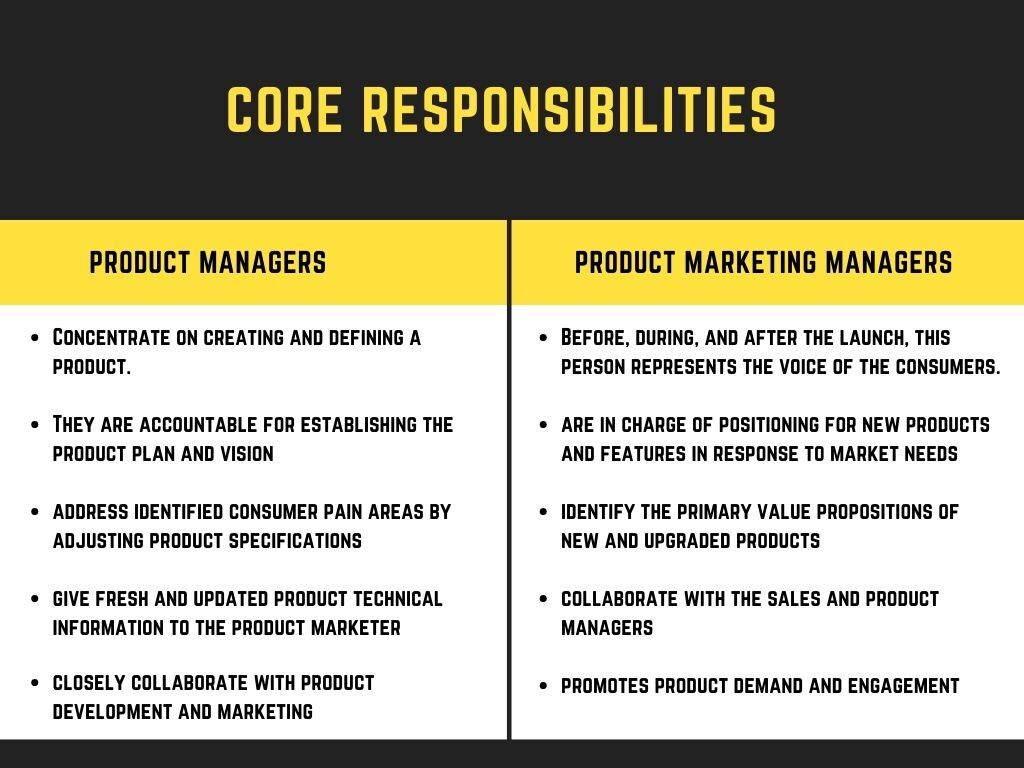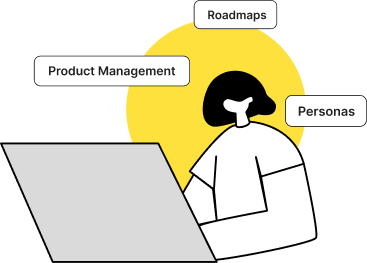Product marketing managers and product managers within a particular business are intimately aware of prospects’ pain points, customers’ frustrations, rivals’ value propositions, and, of course, the product itself. Aside from the overlap, these two responsibilities are pretty distinct – and equally crucial.
The easiest way to explain the distinction is that product managers focus on bringing the right product and features to life. In contrast, product marketing managers are in charge of guiding the product to market.
Failure to correctly define product management and marketing roles might impede an organization’s ability to produce the finest available products and effectively bring them to market. So, let us take a minute to consider how product manager vs. product marketing manager or product marketer is traditionally depicted and what functions they serve.

In an ideal environment, these jobs are clearly defined and do not overlap. Still, we don’t live in one, so let us thoroughly understand the roles and similarities of product managers and product marketing managers.
Core Responsibilities-
The specific definitions of product management and product marketing may vary from firm to firm and frequently rely on how a company organizes and interprets these two functions. However, each position has specific responsibilities. Let’s take a look at those responsibilities –

Product management and product marketing now work closely together in a healthy firm. But I’ve seen what can go wrong when the two teams aren’t on the same page: inconsistent messaging, missed go-live deadlines, and uncertainty about what the product truly accomplishes and the actual value to consumers.
Product and product marketing managers must collaborate to achieve success. It is essential to comprehend how the two responsibilities differ:
Differences –
| Characteristics | Product Manager | Product Marketing Manager |
| Strategy | The product manager establishes the product vision and determines the objectives and actions to realize that vision. To understand consumer demands thoroughly, research the market and create personas. A clear strategy is vital because it allows the product team to make informed judgments – each new feature should be linked to genuine business goals. | The product marketing manager develops the go-to-market plan with the specified overall marketing strategy. This outlines the work required to provide something new, such as launching a product, introducing a feature, or expanding into a new market. Because the aim is to reach the correct audience, the product marketer concentrates on developing positioning and message that will connect with potential purchasers. |
| Customers | The product manager focuses on the user, learning what individuals want to accomplish by utilizing the product. This necessitates soliciting client input on their problems and what they would like to see introduced in the future. The objective is to extract the core of what consumers want before collaborating with the development team to identify technological solutions. | The product marketing manager is primarily concerned with the user’s purchasing characteristics — determining what people need to know about the product (and what it does) to make a purchase. Making buyer personas, mapping out each stage of the customer journey, and offering demonstrations or presentations to prospective consumers are all part of this. The goal is to convert technical capabilities into marketing messages appealing to the target audience. |
| Roadmaps | The product manager prepares the product roadmap, which is a visual depiction of the strategic direction and work plan. The roadmap defines a timetable for the product team’s delivery. The product manager also gathers feature and requirement ideas and scores them based on what they would offer, such as the most outstanding value to the company and users, and adds them to the roadmap. | The product marketer creates the go-to-market roadmap. The goal is to record and organize the scheduling of all cross-functional actions needed to launch a new customer experience. It is guided by the product plan, which includes milestones that keep the team on Track with deliveries. |
| Cross-Functional Teams | The product manager acts as the product leader and advocates for the user and the product. This requires a combination of strategic and tactical effort across teams and communicating the product’s future with colleagues in engineering, marketing, sales, and support. They serve as a link between stakeholders and the teams who will carry out the task. | The product marketing manager ensures that internal, customer-facing teams understand how to communicate the product’s technical value effectively. This might include working with marketing to fine-tune important messages, training sales and support personnel, and ensuring the website is up to date before the next go-to-market. The product the marketing manager also acts as a product specialist for marketing colleagues, collecting KPIs and reporting on market trends. |
Tools | Product Strategy and Roadmapping – Freshflows, Aha!, Monday.com, Airfocus, Tara, ProductPlan Analytics – Amplitude, Google Analytics, Heap, Looker, Mixpanel, Segment, GoodData, Gainsights. Customer Feedback and Surveys – SurveyMonkey, Google Forms, Typeform, Formstack. Design, and Wireframing – Axure, Figma, Flaticon, Framer, InVision, Mockingbird, Moqupus, UXPin. User Experience Testing – Adobe Target, Contentsquare, FullStory, Helio, Hotjar, Lookback,Optimizely, SessionStack. User Onboarding – Inline Manual, Appcues, Intercom, Shepherd, UserIQ, WalkMe. Collaboration and Productivity – Freshflows, Slack, Trello, Lucidspark, Google Workspace. Software Development – Rally, PivotalTracker, AzureDevOps. | User Behavior and Feedback – Segment, Hotjar, UserTesting, UserGuiding, Heap Analytics, EnjoyHQ, Clearbit, Amplitude, Heap. Collaboration and Project Management – Freshflows, Slack, Trello, Asana, Invision, ProductBoard, Process Street, ProofHub, Creative tools – Wistia, Canva, Sketch, InVision, Unbounce, Frame.io, Venngage, Visme, Biteable. Marketing and Automation – Hubspot, MailChimp, Ahrefs, Buzzsuma, Referrizer, INBOX, Mandrill, Drift,Marketing and Automation – Hubspot, MailChimp, Ahrefs, Buzzsuma, Referrizer, INBOX, Mandrill, Drift, Intercom, GetResponse, Buffer, Omnisend, Chameleon |
Now that we’ve discussed their primary responsibilities and differences let’s look at their shared commonalities.
Similarities

Whether these two positions are so complimentary, you may be asking if the same individual can perform them. If you can discover an extraordinary human who doesn’t need to sleep, it’s conceivable. However, we do not recommend it. So what happens if one person takes upon the role of product manager and product marketer –
- Creating comprehensive user/customer/buyer personas
- Creating product pricing strategies and frameworks
- Collecting all the market data
- Creating and controlling the product roadmap
- Managing the Product Backlog
- Synthesizing all internal and external stakeholder feedback on features and priorities
- Performing win/loss analyses
- Conducting competitive research
- Developing and then analyzing customer surveys
- Supervising the development of sales and marketing tools
- Collaborating with the public relations team
- Developing and delivering sales and support training
In many smaller businesses or start-ups, the roles of Product Manager and Product marketer overlap or occasionally combine, so one person is in charge of both product management and product marketing. In a perfect environment, the two would be clearly defined and able to concentrate on each of their distinct skill sets, but, logically, the two might overlap; after all, one thing is relatively constant throughout both positions. Everything they do revolves around the consumer.
Conclusion –
Product managers and marketers are complementing components of the customer success jigsaw that is a firm. A fantastic product is required for marketing to be effective. You need a marketing strategy and the correct message to inspire growth if you produce a fantastic product. Product managers and marketers will have similar characteristics, but it is critical to concentrate on the specific strengths and value additions of each function. Both views are important and necessary for the success of any B2B organization.

